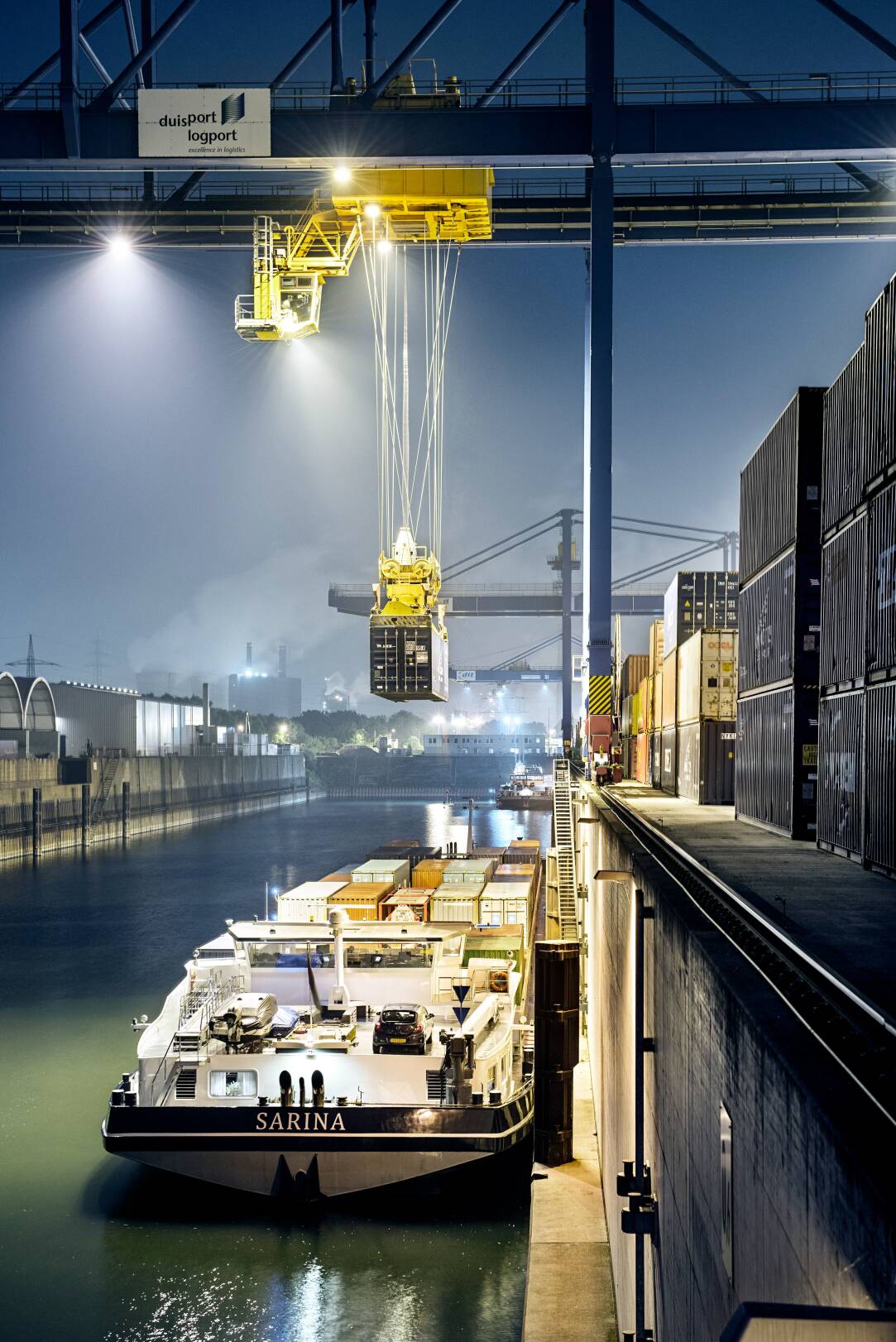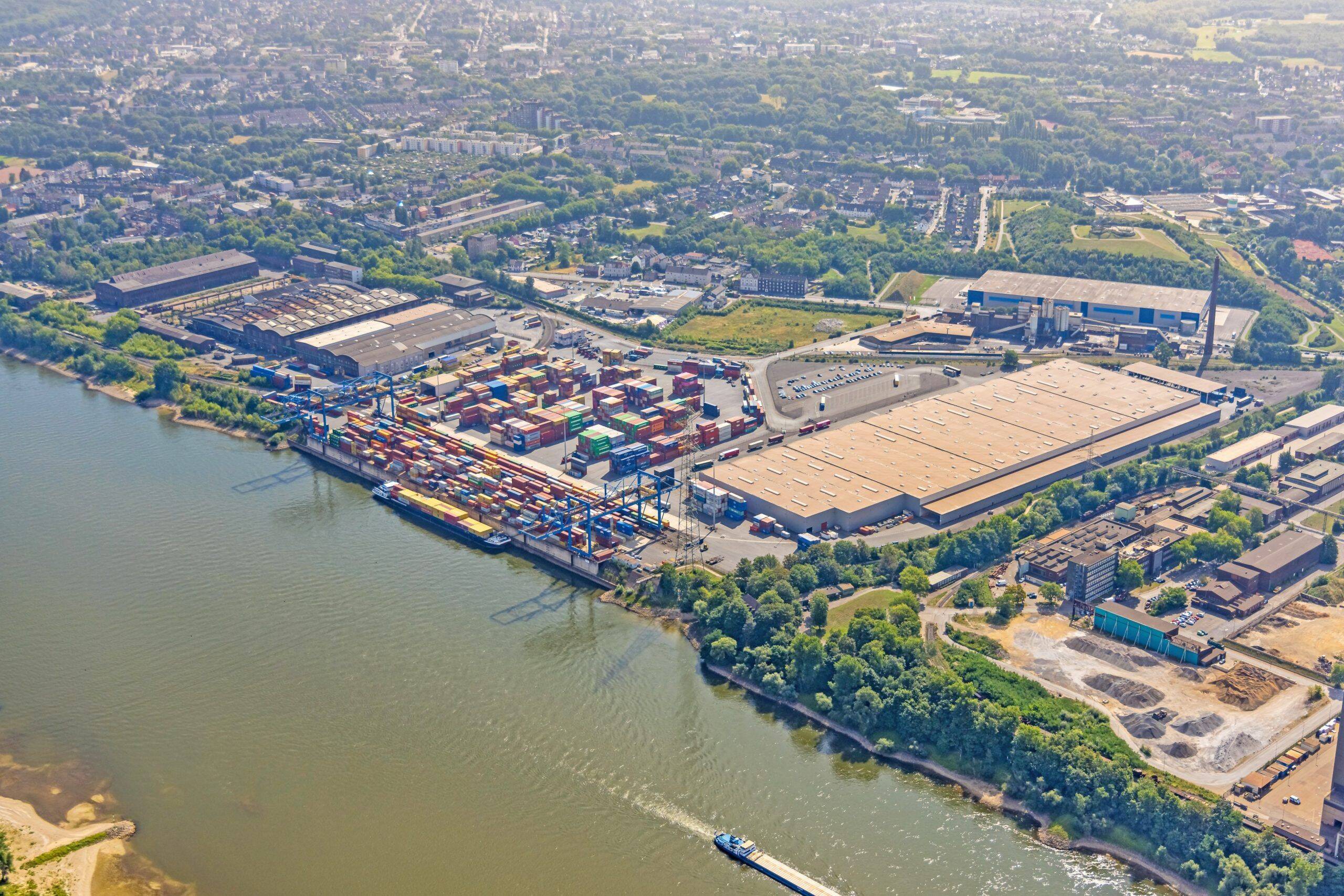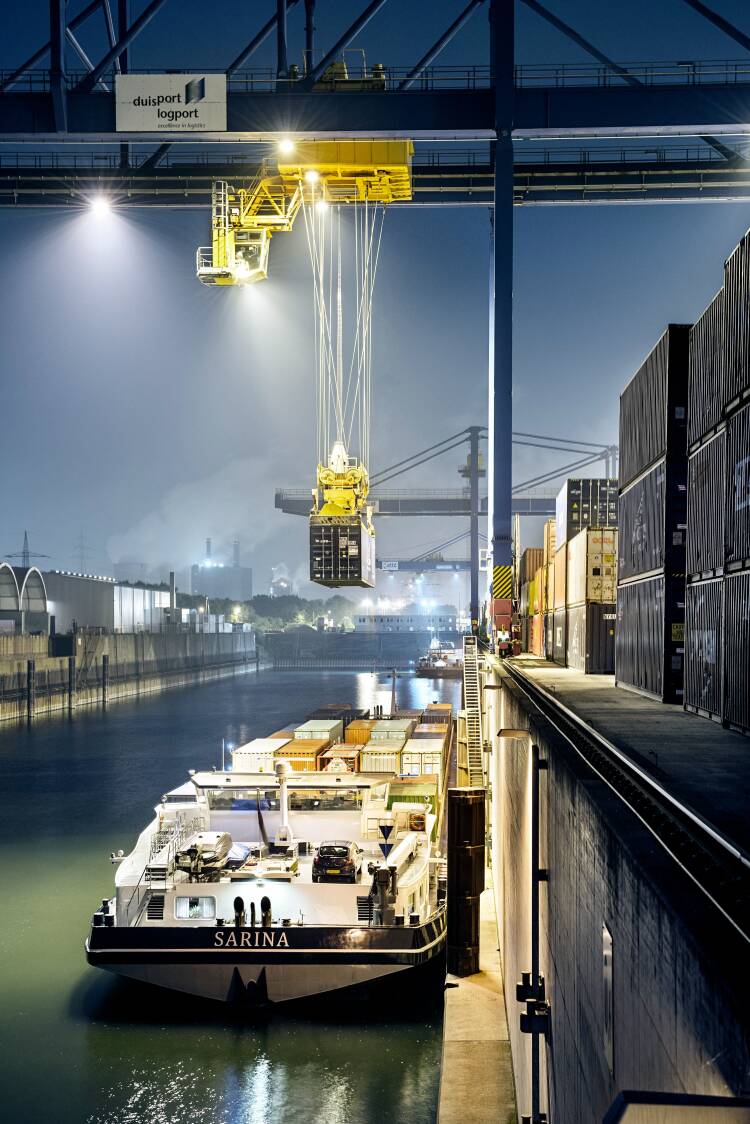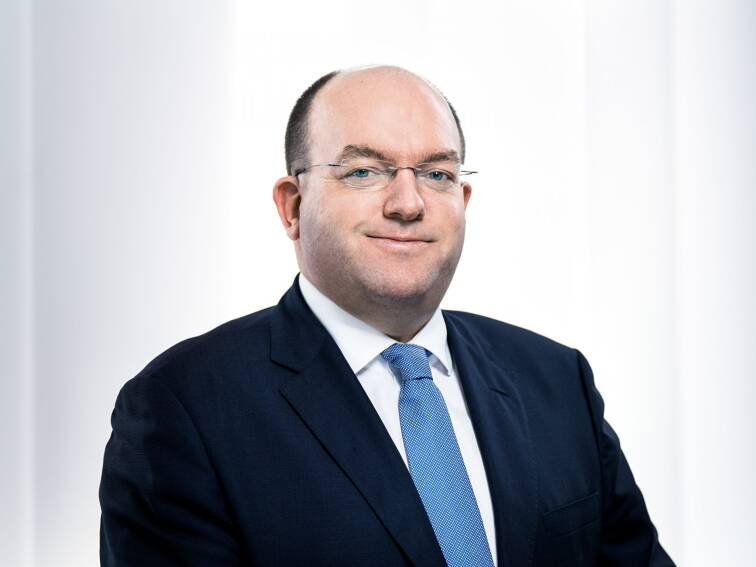Markus Bangen
CEO Duisport on collaboration

Did we pique
your interest?
The cooperation between Rotterdam, Europe’s largest seaport, and duisport, the largest inland port, is unique – and uniquely beneficial. Although the hype seems to have died down a bit, demand for ‘green’ energy sources such as hydrogen, methanol and ammonia will increase, probably dramatically. We are prepared: duisport and the port of Rotterdam have long sought to join forces. Together we will move forward and build functional and resilient supply chains. This is important for our industrial regions and the entire EU economic area.
How do you envisage the future of sustainability and how can duisport benefit from working with Rotterdam?
The Duisburg Gateway Terminal, built on the former coal island in the heart of the port of Duisburg, is in many ways a model project for the future of logistics: across this area, which is the size of 33 football fields, all goods movements are digitally controlled. The enerPort II project plays a crucial role in this. As part of this project, which involves both business and science in equal measure, a concept for the complete energy transformation of the terminal is being implemented in the port of Duisburg. enerPort II should demonstrate for the first time that a terminal of this size can be operated in a completely climate-neutral manner using heat and electricity generated locally. A sustainable energy system will be installed at the DGT that links together renewable energies, energy storage, consumers and various hydrogen technologies.
Another central element of sustainable site development in the port of Duisburg is the logport concept from the duisport group. For many years, duisport has been using the logport strategy to convert former industrial sites – particularly those once used for mining – into modern, multimodally connected logistics locations in a structured manner. The concept not only contributes to the economic development of the port, but also makes a significant contribution to the sustainable transformation of the region.
What all logport projects have in common is reactivating brownfield sites according to ecological and urban development criteria. Particular emphasis is placed on efficient land use, integration into existing transport and supply infrastructures, and environmental and climate protection. New locations are always planned with a view to avoiding additional CO₂ emissions – for example, by promoting rail freight transport, direct access to inland shipping or the integration of sustainable energy concepts.
Sustainability is a central issue at all levels and is becoming an increasingly important economic question. This is the case for us too. Take the energy transition. In recent years there have been intense discussions about how this can be achieved in a concrete and lasting manner. For us there is only one way: we will continue on our growth path, make the port of Duisburg fit for the future and turn it into a hub for decarbonisation. We take great care to provide the infrastructure and know-how to this end. Methanol and Liquid Organic Hydrogen Carriers (LOHC) can already be stored and transhipped in the existing fuel depots at the port of Duisburg. As part of the second expansion phase of the Duisburg Gateway Terminal, a warehouse for dangerous goods containers is currently being built. Here methanol, ammonia, hydrogen and other chemicals can be handled and stored in tank containers. In addition, duisport is pushing ahead with the construction of an electrolysis plant together with Lhyfe GmbH, a pioneer in the production of renewable green hydrogen.
Of course, this is no solo effort. Instead, we have solid and trusted partners at our side, such as the port of Rotterdam. It’s all about collaboration. Recently, for example, we made a joint agreement with the port of Pecém (Brazil). We thus laid the foundations to make it easier for alternative fuels such as green ammonia, e-methanol and other derivatives to reach Europe in the future.

Can you give an example of a successful pilot project completed at the port of Duisburg that was subsequently implemented on a large scale?
Sustainable transformation is currently the major challenge faced by industry. What does sustainability mean for the port of Duisburg?
How can ports support industry initiatives and pilot projects for greater sustainability in the logistics chain?
How is duisport committed to making inland shipping and rail freight transport more sustainable?
How do you work with the port of Rotterdam and what is special about this collaboration?
Ports play a key role in the supply chain and can support industry initiatives and pilot projects in a variety of ways. When we discuss sustainability initiatives in industry in Duisburg, Thyssenkrupp’s long-term plans to produce steel using green hydrogen quickly come up. This is a huge project that is important for boosting the hydrogen economy as a whole. The port of Duisburg supports the project and has already taken concrete steps to become an ‘H2 hub’.
How can we promote alternative forms of power? How can we use fewer resources by digitalising logistics processes? How can we provide companies with low-carbon logistics chains? All these questions and many more show that ports are much more than just transhipment points. They are also innovation platforms.
There are currently a number of means by which we are drawing public attention to waterways as a mode of transportation. This includes the huge expansion of our shore power infrastructure. Or take the Duisburg Gateway Terminal (DGT) which was completed last year. Once fully developed, it will serve as a trimodal hub over approx. 24 hectares, handling up to 850,000 containers. It is an excellent example of holistic and sustainable logistics – especially with regard to inland shipping and rail freight transport: as the largest container terminal in the European hinterland, the DGT is consistently focused on climate-friendly, multimodal transport solutions. It is here that tests are currently being carried out – with the support of scientific experts – to determine how a terminal of this size can be operated in a climate-neutral manner.
Sustainability is always connected to efficiency. That is why duisport will take a major step forwards in digitalising the logistics processes in the port this year with the support of RheinPorts GmbH and introduce a Port Community System similar to those used in seaports. This will make us more efficient and allow us to plan resources more effectively. The system will enable all relevant information about vessels, cargo, ports and logistics service providers to be collected, processed and shared in real time. This will create transparent and efficient communication throughout the entire logistics chain and bring many benefits for all stakeholders.
Markus: There’s a lot that brings us together. In concrete terms, there are the many kilometres of railways, motorways and the Rhine which allow us to create a central and stable supply chain from the seaport, to the inland port and on to the industrial areas of North Rhine-Westphalia. And on a human level, we know and value each other and exchange ideas regularly. That’s a good thing and more important than ever, especially now, when the headlines announce new challenges for the global economy every day and the energy transition requires smart innovation and high investment. It is essential that the two major European logistics hubs pull together. Only then can we continue to do what we have always done: solve problems and find solutions quickly, efficiently and intelligently. Our collaboration on European hydrogen transport chains is an excellent example of this.
Discover the dynamic collaboration between the Port of Rotterdam and Duisport, two of Europe's major logistics hubs. Markus Bangen, CEO at Duisburger Hafen AG (Duisport), explains that this partnership not only strengthens supply chains but also drives innovation in sustainable transport solutions. From hydrogen transport chains to digitalised logistics processes, learn how these ports are paving the way for a greener future.
Scroll down

The cooperation between Rotterdam, Europe’s largest seaport, and duisport, the largest inland port, is unique – and uniquely beneficial. Although the hype seems to have died down a bit, demand for ‘green’ energy sources such as hydrogen, methanol and ammonia will increase, probably dramatically. We are prepared: duisport and the port of Rotterdam have long sought to join forces. Together we will move forward and build functional and resilient supply chains. This is important for our industrial regions and the entire EU economic area.
How do you envisage the future of sustainability and how can duisport benefit from working with Rotterdam?
The Duisburg Gateway Terminal, built on the former coal island in the heart of the port of Duisburg, is in many ways a model project for the future of logistics: across this area, which is the size of 33 football fields, all goods movements are digitally controlled. The enerPort II project plays a crucial role in this. As part of this project, which involves both business and science in equal measure, a concept for the complete energy transformation of the terminal is being implemented in the port of Duisburg. enerPort II should demonstrate for the first time that a terminal of this size can be operated in a completely climate-neutral manner using heat and electricity generated locally. A sustainable energy system will be installed at the DGT that links together renewable energies, energy storage, consumers and various hydrogen technologies.
Another central element of sustainable site development in the port of Duisburg is the logport concept from the duisport group. For many years, duisport has been using the logport strategy to convert former industrial sites – particularly those once used for mining – into modern, multimodally connected logistics locations in a structured manner. The concept not only contributes to the economic development of the port, but also makes a significant contribution to the sustainable transformation of the region.
What all logport projects have in common is reactivating brownfield sites according to ecological and urban development criteria. Particular emphasis is placed on efficient land use, integration into existing transport and supply infrastructures, and environmental and climate protection. New locations are always planned with a view to avoiding additional CO₂ emissions – for example, by promoting rail freight transport, direct access to inland shipping or the integration of sustainable energy concepts.
Can you give an example of a successful pilot project completed at the port of Duisburg that was subsequently implemented on a large scale?
Ports play a key role in the supply chain and can support industry initiatives and pilot projects in a variety of ways. When we discuss sustainability initiatives in industry in Duisburg, Thyssenkrupp’s long-term plans to produce steel using green hydrogen quickly come up. This is a huge project that is important for boosting the hydrogen economy as a whole. The port of Duisburg supports the project and has already taken concrete steps to become an ‘H2 hub’.
How can we promote alternative forms of power? How can we use fewer resources by digitalising logistics processes? How can we provide companies with low-carbon logistics chains? All these questions and many more show that ports are much more than just transhipment points. They are also innovation platforms.
How can ports support industry initiatives and pilot projects for greater sustainability in the logistics chain?

There are currently a number of means by which we are drawing public attention to waterways as a mode of transportation. This includes the huge expansion of our shore power infrastructure. Or take the Duisburg Gateway Terminal (DGT) which was completed last year. Once fully developed, it will serve as a trimodal hub over approx. 24 hectares, handling up to 850,000 containers. It is an excellent example of holistic and sustainable logistics – especially with regard to inland shipping and rail freight transport: as the largest container terminal in the European hinterland, the DGT is consistently focused on climate-friendly, multimodal transport solutions. It is here that tests are currently being carried out – with the support of scientific experts – to determine how a terminal of this size can be operated in a climate-neutral manner.
Sustainability is always connected to efficiency. That is why duisport will take a major step forwards in digitalising the logistics processes in the port this year with the support of RheinPorts GmbH and introduce a Port Community System similar to those used in seaports. This will make us more efficient and allow us to plan resources more effectively. The system will enable all relevant information about vessels, cargo, ports and logistics service providers to be collected, processed and shared in real time. This will create transparent and efficient communication throughout the entire logistics chain and bring many benefits for all stakeholders.
How is duisport committed to making inland shipping and rail freight transport more sustainable?
Sustainability is a central issue at all levels and is becoming an increasingly important economic question. This is the case for us too. Take the energy transition. In recent years there have been intense discussions about how this can be achieved in a concrete and lasting manner. For us there is only one way: we will continue on our growth path, make the port of Duisburg fit for the future and turn it into a hub for decarbonisation. We take great care to provide the infrastructure and know-how to this end. Methanol and Liquid Organic Hydrogen Carriers (LOHC) can already be stored and transhipped in the existing fuel depots at the port of Duisburg. As part of the second expansion phase of the Duisburg Gateway Terminal, a warehouse for dangerous goods containers is currently being built. Here methanol, ammonia, hydrogen and other chemicals can be handled and stored in tank containers. In addition, duisport is pushing ahead with the construction of an electrolysis plant together with Lhyfe GmbH, a pioneer in the production of renewable green hydrogen.
Of course, this is no solo effort. Instead, we have solid and trusted partners at our side, such as the port of Rotterdam. It’s all about collaboration. Recently, for example, we made a joint agreement with the port of Pecém (Brazil). We thus laid the foundations to make it easier for alternative fuels such as green ammonia, e-methanol and other derivatives to reach Europe in the future.
Sustainable transformation is currently the major challenge faced by industry. What does sustainability mean for the port of Duisburg?
Markus: There’s a lot that brings us together. In concrete terms, there are the many kilometres of railways, motorways and the Rhine which allow us to create a central and stable supply chain from the seaport, to the inland port and on to the industrial areas of North Rhine-Westphalia. And on a human level, we know and value each other and exchange ideas regularly. That’s a good thing and more important than ever, especially now, when the headlines announce new challenges for the global economy every day and the energy transition requires smart innovation and high investment. It is essential that the two major European logistics hubs pull together. Only then can we continue to do what we have always done: solve problems and find solutions quickly, efficiently and intelligently. Our collaboration on European hydrogen transport chains is an excellent example of this.
How do you work with the port of Rotterdam and what is special about this collaboration?
Did we pique
your interest?
Discover the dynamic collaboration between the Port of Rotterdam and Duisport, two of Europe's major logistics hubs. Markus Bangen, CEO at Duisburger Hafen AG (Duisport), explains that this partnership not only strengthens supply chains but also drives innovation in sustainable transport solutions. From hydrogen transport chains to digitalised logistics processes, learn how these ports are paving the way for a greener future.
Markus Bangen
CEO Duisport on collaboration

